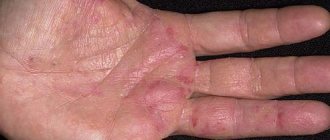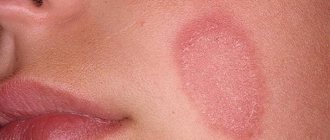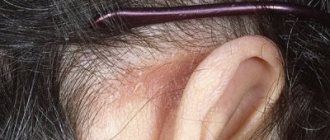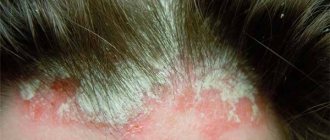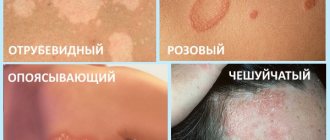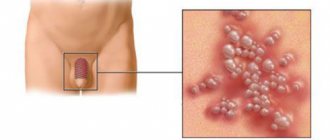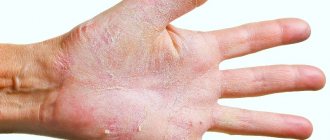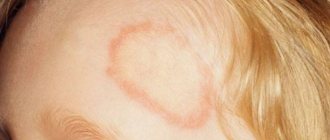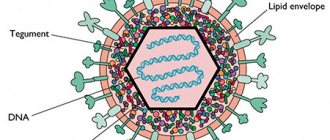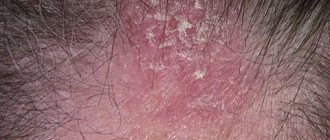Ringworm-like spots on the body may itch or cause no noticeable discomfort. There are several types of lichen, which appear in the form of nodules, spots, and plaques. Similar symptoms may indicate other pathologies. For proper treatment, it is necessary to find out the main cause of changes in the skin. If spots on the body that look like lichen do not itch, the doctor will determine what it is and prescribe therapy.
Causes of lichen
Ringworm appears for various reasons. Many people have a fungus that causes the disease, but it never gets activated. Ringworm can be transmitted from sick people and animals, but there are cases of the development of a disease of unknown etiology. The pathology can go away on its own or become chronic or change. Spots similar to lichen do not always itch (different manifestations are visible in the photo).
The main causes of skin damage are external and internal.
- External:
- wearing clothes that do not allow air to pass through,
- a trip to the sea, a visit to the solarium,
- insufficient hygiene,
- contact with infected people or animals,
- mechanical damage to the epidermis with subsequent infection.
- Internal:
- increased sweating,
- weak immunity,
- lack of vitamins,
- severe stress or persistent depression,
- predisposition to mycoses on the skin,
- obesity,
- long-term use of contraceptives,
- hormonal changes
- genetic predisposition.
Prevention
To avoid becoming infected with lichen, you must follow the following recommendations:
- Do not have contact with stray animals.
- Monitor your thyroid function.
- Observe personal hygiene rules.
- Take vitamins and minerals to strengthen your immune system.
- Always wash your hands after walking.
- Wear gloves when working in your summer cottage.
- Eat properly.
- Avoid frequent stress.
When taking antibiotics, do not forget about drugs to protect the intestinal microflora.
The main forms of lichen and methods of their treatment
Ringworm is a term used to refer to skin diseases of various etiologies. They differ in symptoms, causes and consequences, and do not always cause itching. Therefore, if a spot appears on the skin that looks like lichen, but does not itch, you still need to consult a doctor. Drug therapy and diet may be required.
There are 8 forms of the disease:
- Shingles . In children it manifests itself as chickenpox; in adults it affects a large area of the ribs. It is characterized by the appearance of small watery blisters that burst. A crust forms in these places. The affected area is very itchy and sometimes painful. The disease goes away in 3-4 weeks. To eliminate itching, Acyclovir ointment and tablets are prescribed, and, if necessary, analgesics.
- Red flat . The form of lichen is expressed in the appearance of shiny plaques. They differ in color from the rest of the skin. Over time, the plaques become bluish or pink-gray, can increase in size and reach a diameter of 10 cm. The disease is accompanied by severe itching, there is no peeling.
- Pityriasis rosea (Gibera) . Itchy plaques appear on the skin, completely pink or with a border around the edge. Small rashes appear around them. The disease more often manifests itself in adolescents against the background of hormonal development and stressful situations. The disease goes away on its own within a month and a half. In case of severe manifestations, the antihistamine drug Chloropyramine, treatment with water-zinc mash, and ultraviolet irradiation procedures are prescribed.
- Pityriasis alba . The disease of this form is chronic and can occur even if all body systems work without disturbances. The main symptom is the presence of white spots on the skin that do not peel or itch and go away on their own.
- Versicolor (pityriasis versicolor, cauliflower) . The causative agent is the fungus pityrosporum oval. The form is not infectious. Spots of different colors appear on the skin of the back, neck, arms, and under the chest. Moreover, they can change color depending on the time of year: in summer they are colorless, the skin does not tan, in winter they become brown, pink, yellow. External symptoms do not cause itching, but grow, affecting an increasingly larger area. The disease can last a long time with periods of extinction and relapse. For external treatment, ointments are used: Ketoconazole, Miconazole, sulfuric acid, salicylic alcohol 5%, iodine-based sprays, if the patient does not have allergies. In advanced cases, the doctor prescribes the following tablets: Terbizil, Fungavis, Nizoral, Ketoconazole, Mikosist. If the damage is minor, sometimes lotions of apple cider vinegar, calendula tincture, turnip juice, cranberry, string and eucalyptus decoctions help.
- Ringworm or trichophytosis . Ringworm is transmitted from infected people or animals and appears on any part of the body. If the scalp is affected, bald spots appear in this area. Large spots itch, itch, and become crusty. For local treatment, ointments and shampoos are prescribed: Ketoconazole, Mycoseptin, Clotrimazole, Griseofulvin, treatment with iodine and salicylic acid. In the chronic form, the drug Griseofulvin, immunomodulators and vitamins are prescribed.
- Ringworm - eczema. Various factors contribute to the occurrence of the disease:
- external (mechanical, chemical, thermal, etc.),
internal (diseases of the liver, kidneys, gastrointestinal tract, endocrine, nervous system, etc.)
In the treatment of eczema, external forms of corticosteroid hormones (Hydrocortisone ointment) are widely used. Also, in some cases, sedatives (valerian preparations, tranquilizers), vitamins (B1, B6, C, etc.), desensitizing drugs, etc., and diet are prescribed.
- Scaly lichen - psoriasis . The cause of the development of the disease has not yet been fully elucidated. Psoriatic plaques most often first appear on areas exposed to friction and pressure - the surfaces of the elbows and knees, on the buttocks. However, such rashes can occur on any part of the skin, including the scalp, palms and soles, and external genitalia. The first step in treating a simple or so-called winter psoriasis (psoriasis vulgaris) – identification and elimination of possible deficiency of vitamin D in the blood. Ointments based on solid oil (Cytopsor, Kartalin, Akrustal, Magnipsor, Antipsor) are applied topically.
Stages of the disease
Ringworm develops in two stages: the incubation period and the stage of active clinical manifestations. At the first stage, the fungal pathogen of the disease penetrates the human body, actively multiplies and tries to resist the immune system. The second stage occurs when the immune system cannot cope with a fungal infection and the accumulation of an infectious agent is sufficient for a maximum surge in infection. Skin formations and the first symptoms appear: burning, itching, blistering neoplasms, spots and hair loss by breaking off. If neglected, the disease can take a chronic form, leading to baldness and dysfunction of the gonads.
Shingles - occurs in four periods: incubation, prodromal, exacerbation, maximum damage. During the incubation period, the virus penetrates healthy cells, resists the immune system and begins the process of reproduction. The second stage includes the appearance of headache and skin itching without characteristic rashes. The acute period includes a neurological syndrome and skin rash. At the time of maximum damage, a person often experiences depression and pain in the affected area, which can last for several years.
Pink – develops over three stages. The first stage includes the appearance of a maternal neoplasm localized in delicate areas of the skin. The duration of the stage is approximately one week. The second is characterized by the spread of “children” from maternal education. In the third stage, the spots resemble elongated bubble cutouts.
Red – develops in five main stages: acute, stationary, progressive, resolution and remission. At the first stage, spots actively appear over several months. At the second stage, the symptoms temporarily subside before the start of a new intensified surge - a progressive stage, at which unbearable pain and burning sensations appear, plaques and erosions appear. The resolution stage is based on medical removal of tumors, after which the process of natural wound healing occurs. At the stage of remission, clinical and psychological manifestations of the disease are completely absent.
Multi-colored - occurs in three periods. In the first, dots barely perceptible to the eye appear. In the second, the dots take on a larger size, peeling of the skin and increased sweating occur. The follicular stage leads to the appearance of purulent formations.
Important! Ringworm activity can only be detected using a Woody lamp.
Other causes of lichen-like spots on the body and their treatment
If spots on the body that look like lichen itch or don’t itch, only a doctor can tell you how to treat it. There are many reasons, and it is important to get the correct diagnosis. What other reasons could there be for the appearance of such formations on the skin?
Dark spots
Brown skin coloring occurs due to a lack or excess of pigment in the tissues. Common reasons for their appearance are:
- hormonal changes
- liver failure,
- gynecological diseases,
- metabolic disorder,
- avitaminosis.
Lyme disease
This infectious disease, borreliosis, is transmitted through the bite of a human by an ixodid tick. A spot forms at the site of the lesion, which gradually increases and can reach a diameter of 20 cm. In the center, the skin is pale, along the edges there is redness, swelling, and pain when pressed. New outbreaks cannot be ruled out.
At the same time, intoxication of the body occurs, weakness is felt, lymph nodes become enlarged, joints, liver, and head hurt.
In case of illness, comprehensive treatment in a hospital is necessary. Timely access to the clinic is of great importance. Therefore, if spots on the body appear on the body that look like lichen, they itch, photos on the Internet will not give you the opportunity to figure it out on your own, you need to urgently seek qualified medical help.
Allergic reaction
The appearance of acne and redness on the skin can be caused by wearing underwear made of synthetic materials, using low-quality cosmetics, hypothermia, eating certain foods, and taking medications. In some cases, the symptoms are identical to those of lichen and are cause for concern.
Depending on the complexity of the reaction, treatment is selected. To eliminate formations, it may be enough to avoid contact with the allergen. But sometimes long-term treatment with antihistamines is required.
Ring-shaped erythema
The disease affects young men. Spots appear on the body, similar to lichen, they itch slightly or there is no itching at all, and they peel off. The formations are constantly increasing, forming rings, half-rings, and various “patterns.” A pink edging is visible along the edge, but in the center the skin remains unchanged.
To eliminate the disease, treatment of the respiratory and digestive system begins. For treatment, hormonal ointments are prescribed, and antihistamine tablets are prescribed orally.
Alopecia areata
The cause of partial baldness is not fully understood. Autoimmune death of hair follicles is suspected. The only symptom of the disease is the absence of hair on the scalp. Pathology manifests itself in different forms: lesions with pronounced bald spots, loss of up to 40% of hair, loss along the edges, on the back of the head or crown.
The treatment is long-term. Prescribe Prednisolone for at least 1.5 months with a gradual reduction in dose, injections of nicotinic acid, zinc oxide, and injection of hormones into the affected area.
Seborrheic dermatitis
The main reason for the development of the disease is increased sweating. Symptoms of the disease: flaky yellowish spots with a pronounced edging. Cracks and crusts are observed in the folds of the skin. Often pathogenic microorganisms attach to the affected areas, causing inflammation.
Treatment is long and complex. They prescribe Prednisolone, Betamethasone, and sedatives to restore the nervous system and get proper sleep. For external treatment, use brilliant green, pastes based on birch tar, naphthalan.
In most cases, the functioning of the digestive organs is disrupted, so ox bile extract, cholic acid, and Pancreatin are recommended.
Diagnostics
If signs of lichen appear, you just need to contact a dermatologist . Is it worth panicking? No. Symptoms and the lesion will help the doctor determine the type of disease and prescribe adequate treatment. Diagnosis is limited to examination using a special lamp; if necessary, skin tests can be prescribed. Professional advice is simply necessary.
You should not self-medicate, otherwise there is a risk of developing the disease to such an extent that the lichen spreads over a large area.

